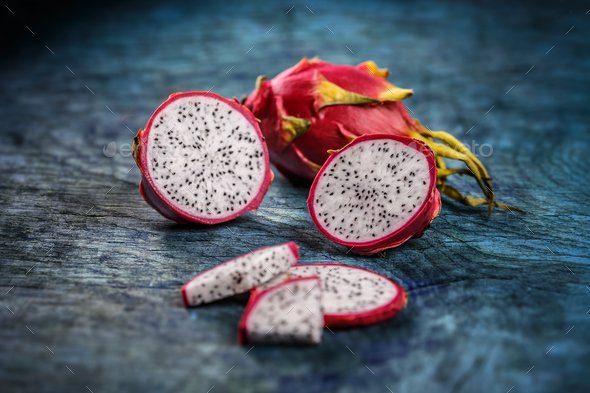
When I first heard the name dragon fruit, I was first amused to be very honest, but I had no idea I had eaten this tropical fruit before, believe me, it was very tasty and inviting to eat.
Dragon fruit usually grows on the Hylocereus cactus, also referred to as the Honolulu queen, whose flowers only open at night, fascinating right?
This Honolulu queen plant is native to southern Mexico and Central America, but it is grown all over the world. This dragon fruit goes by numerous names, including pitaya, pitahaya, or strawberry pear.
Dragon fruit looks exotic, but its flavors are quite similar to other fruits. Its taste can be described as a slightly sweet cross between a kiwi and a pear fruit.
The two common species found have bright red skin with green scales that resemble a dragon; that’s how the name was derived.
The widely available variety has white pulp with black seeds in it, while the less common type with red pulp and black seeds exists as well.
Nutrition Value of Dragon Fruit
Dragon fruit contains very little amounts of various nutrients. It is also a great source of iron, magnesium, and fiber.
Here’s the nutrition value for a serving of 3.5 ounces, or 100 grams [1]:
- Calories: 60
- Protein: 1.2 grams
- Fat: 0 grams
- Carbs: 13 grams
- Fiber: 3 grams
- Vitamin C: 3% of the RDI
- Iron: 4% of the RDI
- Magnesium: 10% of the RDI
Due to a large amount of fiber and magnesium, as well as the extremely low-calorie content, dragon fruit can be regarded as highly nutrient-dense fruit.
Amazing Perks of Dragon Fruit
Serves as Antioxidants
Dragon fruit contains several types of antioxidants. These antioxidants are compounds that guard your cells from toxin molecules called free radicals, which cause chronic diseases.
According to experts, these are some of the main antioxidants contained in dragon fruit pulp [2]
- Betalains: Located in the pulp of red dragon fruit, these deep red pigments have been shown to protect “bad” LDL cholesterol from becoming oxidized or damaged [3].
- Hydroxycinnamates: This group of compounds has demonstrated anticancer activity in test-tube and animal studies [4].
- Flavonoids: This large, diverse group of antioxidants is linked to better brain health and a reduced risk of heart disease [5] [6]
A research compared the antioxidant properties of 17 tropical fruits and berries, however, dragon fruit’s antioxidant capacity was not very high, it was found to be best at protecting certain fatty acids from free radical damage [8] [9]
Dragon fruit is a low-calorie fruit that contains less sugar and fewer carbs than many other tropical fruits.
Dragon fruit contains prebiotic fibers that enhance the growth of vital bacteria in your gut used potentially improving metabolic health (10).
In a study carried out in mice on a high-fat, high-carb diet, a certain group that received dragon fruit juice had better blood sugar responses and reductions in some liver enzyme markers, while another liver enzyme marker significantly increased (11).
How To Prepare Dragon Fruits
Dragon fruit can be very intimidating yet very easy to eat.
Here’s an easy way to eat dragon fruit:
- Choose a ripe fruit with bright red, evenly colored skin that gives slightly when squeezed.
- Use a sharp knife and cut straight through the fruit, slicing it in half.
- You can use a spoon to eat the fruit out of the skin or peel the skin off and slice the pulp into small pieces.
Great ideas for serving dragon fruit:
- Slice it up and eat it as is.
- Chop it into little chunks and top with Greek yogurt with chopped nuts.
- Include it in a salad or parfait.
Disclaimer: The above information written in this article is solely meant for informational and educational purposes only. The article written/published does not intend to diagnose, treat or cure any disease and should not be treated as medical advice.
Photo Credits: Web






